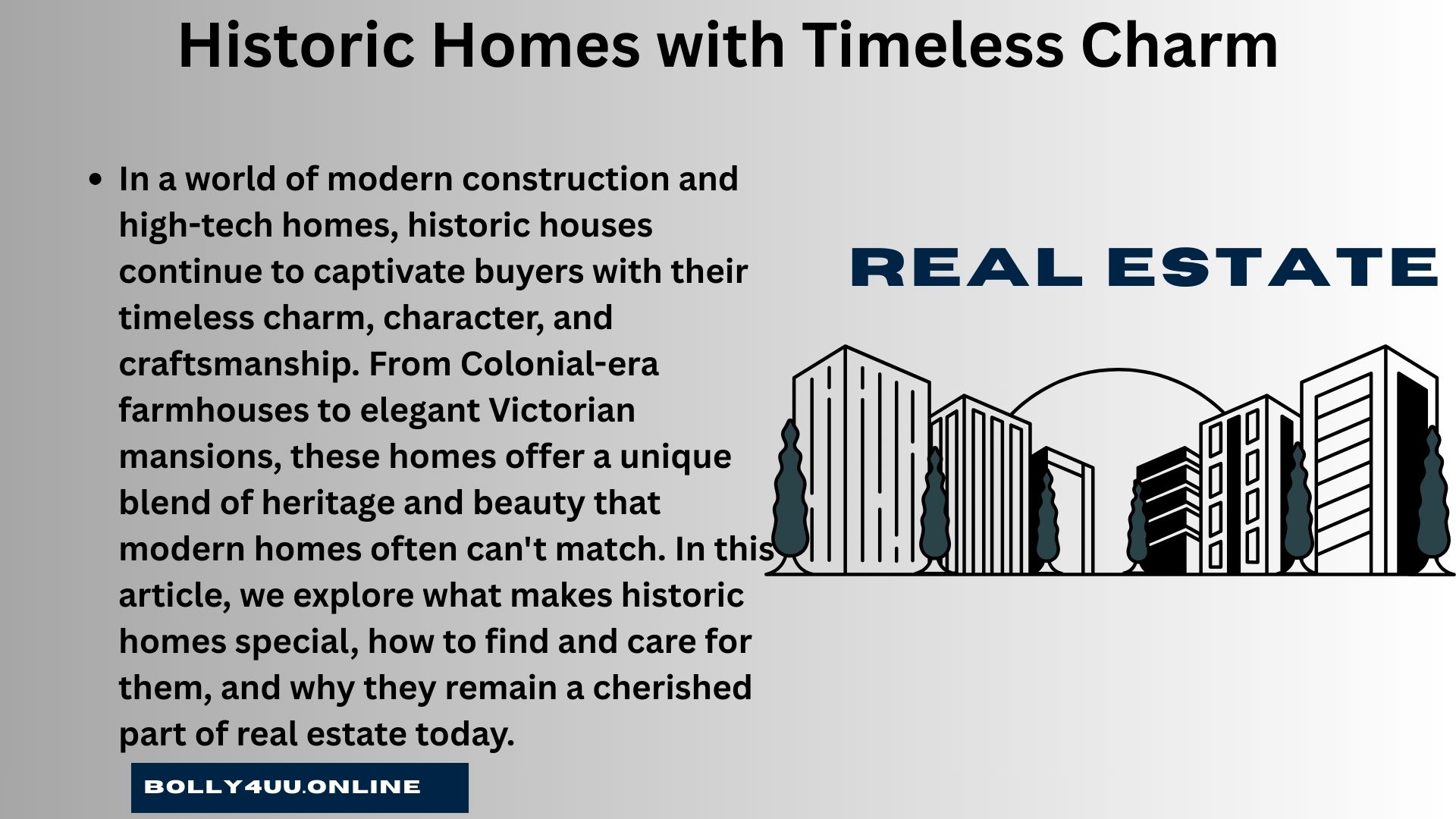Introduction
In a world of modern construction and high-tech homes, historic houses continue to captivate buyers with their timeless charm, character, and craftsmanship. From Colonial-era farmhouses to elegant Victorian mansions, these homes offer a unique blend of heritage and beauty that modern homes often can’t match. In this article, we explore what makes historic homes special, how to find and care for them, and why they remain a cherished part of real estate today.
1. What Is a Historic Home?
A historic home is typically a property that is:
- At least 50 years old
- Architecturally significant or associated with a historic event or person
- Listed on a national, state, or local historic registry (like the U.S. National Register of Historic Places)
These homes often feature:
- Original woodwork and trim
- Period-specific architecture
- Handcrafted details
- Antique fixtures and flooring
Owning one means preserving a piece of living history.
2. The Unique Appeal of Timeless Charm
What makes historic homes so charming?
- Authentic materials: Brick, stone, hardwood, copper, and glasswork rarely found today
- Architectural details: Crown moldings, wrap-around porches, stained glass windows
- Stories and legacy: Each home tells a tale of a different era
- Community character: Often found in well-preserved, walkable neighborhoods
Historic homes offer a warmth and personality that newer homes may lack.
3. Popular Historic Architectural Styles
When buying or admiring historic homes, you’ll encounter beautiful styles like:
- Victorian: Ornate, colorful, with turrets and gables
- Craftsman: Handcrafted woodwork, exposed beams, and large front porches
- Colonial Revival: Symmetrical facades, shutters, and dormer windows
- Tudor: Steeply pitched roofs, arched doorways, and half-timbering
- Federal and Georgian: Elegant symmetry with brick exteriors and classical detailing
Each style reflects the craftsmanship and cultural influences of its era.
4. Where to Find Historic Homes in the U.S.
Some cities are famous for their historic districts and preservation efforts. Top picks include:
- Savannah, GA – Cobblestone streets and antebellum homes
- Charleston, SC – Georgian and Federal-style mansions
- New Orleans, LA – French and Spanish Creole architecture
- Boston, MA – Brick rowhouses and Colonial-era homes
- San Francisco, CA – Iconic Painted Ladies and Victorian gems
Explore designated Historic Districts for properties rich in character and value.
5. Financial Considerations and Incentives
Owning a historic home may come with:
✅ Tax credits for approved restorations
✅ Local grants or low-interest loans for preservation
✅ Higher insurance premiums (due to repair costs and materials)
✅ Limitations on alterations if the home is in a regulated district
It’s essential to understand the costs and benefits before investing.
6. Renovating a Historic Home (Without Losing the Charm)
Restoring a historic home? Follow these guidelines:
- Work with licensed professionals experienced in preservation
- Use authentic or replica materials
- Respect the original layout and architectural details
- Check local historic commissions before making major changes
- Upgrade systems (HVAC, plumbing, electrical) while preserving the structure
Preservation doesn’t mean limitation—it’s about balance.
7. SEO Strategy: Keywords for Targeted Traffic
To attract readers and search traffic, use SEO-friendly phrases such as:
- “historic homes for sale 2025”
- “restoring historic houses”
- “Victorian homes with original details”
- “buying a home in a historic district”
These should be naturally included in:
- Title tags and meta descriptions
- Header tags (H2, H3)
- Alt text on images of historic architecture
Avoid keyword stuffing and focus on helpful, user-first content.
8. Google AdSense Compliance for Real Estate Content
To ensure monetization compliance:
✅ Use original, accurate, and user-focused content
✅ Avoid exaggerated claims like “guaranteed profit” or “secret historic homes”
✅ Make sure your site is mobile-friendly and fast-loading
✅ Place ads in non-intrusive areas that don’t interrupt reading
✅ Clearly label any sponsored or affiliate content
A good user experience supports both SEO and revenue.
9. The Long-Term Value of Historic Properties
Historic homes tend to hold their value well, thanks to:
- Desirable locations near city centers or preserved neighborhoods
- Architectural uniqueness that sets them apart
- Community efforts to preserve and maintain them
- A strong emotional appeal to buyers
If well-maintained, historic homes can be appreciating assets.
10. Tips for Buying a Historic Home
Before you sign the dotted line:
✅ Get a home inspection with a specialist familiar with old homes
✅ Research zoning laws and local preservation ordinances
✅ Understand what changes you can and can’t make
✅ Check for lead paint, asbestos, or outdated wiring
✅ Budget for ongoing maintenance
Being informed helps you protect your investment and the home’s heritage.
Conclusion
Historic homes with timeless charm offer more than just a roof over your head—they provide a window into the past and a lifestyle rooted in elegance, craftsmanship, and character. Whether you’re drawn to the romance of a Victorian or the simplicity of a Colonial farmhouse, owning a historic home is about celebrating the artistry and authenticity of a bygone era.
